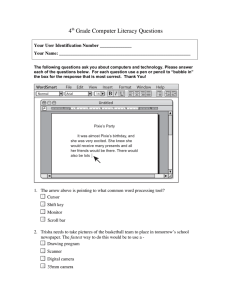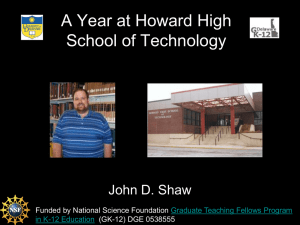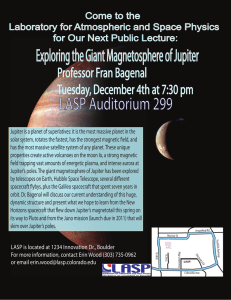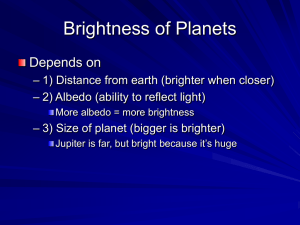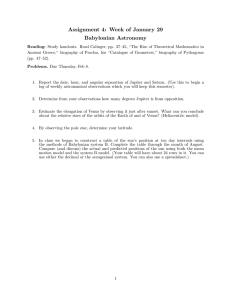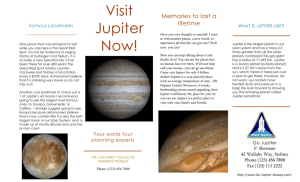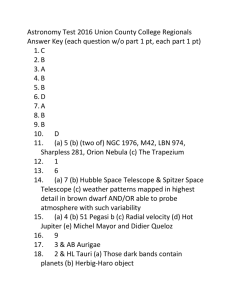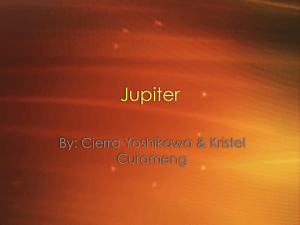Document 13614776
advertisement
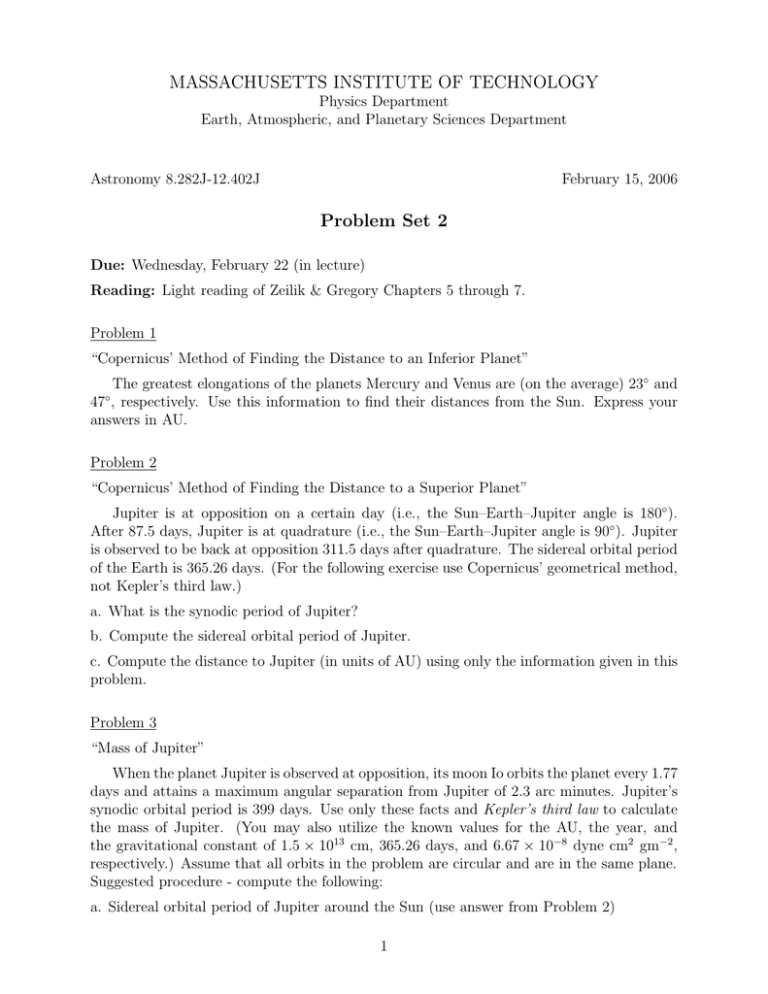
MASSACHUSETTS INSTITUTE OF TECHNOLOGY Physics Department Earth, Atmospheric, and Planetary Sciences Department Astronomy 8.282J­12.402J February 15, 2006 Problem Set 2 Due: Wednesday, February 22 (in lecture) Reading: Light reading of Zeilik & Gregory Chapters 5 through 7. Problem 1 “Copernicus’ Method of Finding the Distance to an Inferior Planet” The greatest elongations of the planets Mercury and Venus are (on the average) 23◦ and 47 , respectively. Use this information to find their distances from the Sun. Express your answers in AU. ◦ Problem 2 “Copernicus’ Method of Finding the Distance to a Superior Planet” Jupiter is at opposition on a certain day (i.e., the Sun–Earth–Jupiter angle is 180◦ ). After 87.5 days, Jupiter is at quadrature (i.e., the Sun–Earth–Jupiter angle is 90◦ ). Jupiter is observed to be back at opposition 311.5 days after quadrature. The sidereal orbital period of the Earth is 365.26 days. (For the following exercise use Copernicus’ geometrical method, not Kepler’s third law.) a. What is the synodic period of Jupiter? b. Compute the sidereal orbital period of Jupiter. c. Compute the distance to Jupiter (in units of AU) using only the information given in this problem. Problem 3 “Mass of Jupiter” When the planet Jupiter is observed at opposition, its moon Io orbits the planet every 1.77 days and attains a maximum angular separation from Jupiter of 2.3 arc minutes. Jupiter’s synodic orbital period is 399 days. Use only these facts and Kepler’s third law to calculate the mass of Jupiter. (You may also utilize the known values for the AU, the year, and the gravitational constant of 1.5 × 1013 cm, 365.26 days, and 6.67 × 10−8 dyne cm2 gm−2 , respectively.) Assume that all orbits in the problem are circular and are in the same plane. Suggested procedure ­ compute the following: a. Sidereal orbital period of Jupiter around the Sun (use answer from Problem 2) 1 b. Distance of Jupiter from the Sun (using Kepler’s third law) c. Distance from Earth to Jupiter at opposition d. Physical size of Io’s orbit around Jupiter e. Mass of Jupiter (you may assume that the mass of Io is negligible in comparison to the mass of Jupiter.) Problem 4 “Black Hole at the Center of Our Galaxy” Professor Andrea Ghez of UCLA (a former MIT undergrad), and her team at UCLA has determined the mass of the black hole lurking at the center of our Galaxy. Conveniently, Nature has arranged for a number of stars to be orbiting the black hole. By overcoming a number of substantial technical challenges, including the heavy dust obscuration toward the Galactic center and the small angular size of the orbits as observed from Earth, Ghez and collaborators have determined the orbits of seven of the stars orbiting the central black hole. Star S0­19 has an orbital period of 37 years, and a semimajor axis of 1720 AU. The orbit is actually not circular, but for now use the expression derived for circular orbits to compute the mass of the black hole about which this star is orbiting. Express your answer in solar masses, M� . Problem 5 “Geosynchronous Satellite” A communications satellite used to relay television broadcasts is launched into a circular geosynchronous orbit above the Earth’s equator. (The orbit of such a satellite has the same angular frequency as that associated with the Earth’s rotation.) A person who owns a satellite receiving dish can thereby point the dish at the satellite and expect it to remain properly aimed for an indefinite time. a. What radius is required for the orbit of the satellite in order for it to be geosynchronous? b. (Optional) For the owner of a satellite receiving dish in Boston (42◦ north of the Earth’s equator) how many degrees away from the zenith (“directly overhead”) would the satellite dish have to be pointed to view an optimally placed geosynchronous satellite? Problem 6 (Optional) “Dynamical Timescale of the Earth” Show that if a straight, frictionless, underground tunnel were constructed between Boston and Washington, DC, the intercity travel time would be about 42 minutes and that no engine would be required to power the vehicle in either direction. Assume that the Earth is a sphere of uniform density. The mass, M , and radius, R, of the Earth are 6 × 1027 gm and 6400 km, respectively. 2 z r R Cross section of Earth with tunnel. [Hints: a. Show that the component of force along the z direction is the magnitude of the radial force times the factor z/r. b. If you have not had differential equations yet, you may use the fact that an equation of the form: d2 z + ω 2 z = 0, dt2 has solutions of the form z = A sin(ωt + φ), where A and φ are constants that are determined from the “initial conditions”.] 3

